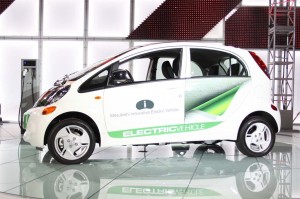
Mitsubishi hopes buyers will be drawn to the low price and high efficiency of its new "i" battery car.
While it may not have the marketing muscle behind it, Mitsubishi is likely to get some serious buzz for its new “i” battery car thanks to a 126 MPGe rating from the EPA – significantly higher than its two key electric vehicle competitors, the Nissan Leaf and Chevrolet Volt.
Originally known as the iMiEV, the curiously named Mitsubishi subcompact will also have a significant price advantage when it hits market in the coming months. That could complicate the battle for supremacy in the small but potentially fast-emerging battery car market.
Since electric vehicles don’t use gasoline, the Environmental Protection Agency has adopted a complex formula to help motorists rate their energy efficiency in a way that can be reasonably compared to a conventional automobile, hence the designation Miles Per Gallon equivalent, or MPGe.
The Mitsubishi i is rated at 126 MPGe in urban driving situations and 99 MPGe on the highway. (Battery-based vehicles typically don’t do as well at freeway speeds because it takes more energy to move faster and there are less opportunities to recapture wasted energy.)
By comparison, the Nissan Leaf is rated at 106 MPGe City and 92 Highway, while EPA pegs the Chevy Volt’s numbers at 95 and 90. Even the tiny Tesla Roadster doesn’t match Mitsubishi’s 4-door offering. The latest version of that electric sports car has a 119 MPGe rating.
Another plus for Mitsubishi is its price tag, at $27,990, the quirky little hatchback will have a base price about $5,000 below that of the Leaf and $13,000 under Volt. Those numbers don’t take into account the $7,500 federal tax credit for qualifying high-mileage vehicles, nor any additional state and local incentives. Under some circumstances, it is possible for a California buyer living in the right community and working for the right employer to purchase a Nissan Leaf for as little as $12,000.
“We feel that with the combination of capability, affordability, and high level of efficiency offered by the 2012 Mitsubishi i will prove very appealing to consumers considering EV transportation,” said Yoichi Yokozawa, President and CEO of Mitsubishi Motors North America.
There are several drawbacks to the Mitsubishi i. It is considered a subcompact according to EPA standards, and has a notably smaller interior than either Leaf or Volt – though its smaller exterior footprint could also make it easier to mark in tight spaces.
Meanwhile, the Mitsubishi offering is expected to yield just 62 miles per charge compared to 73 for the Nissan. The Chevy Volt is a so-called “extended-range electric vehicle.” It only delivers about 35 miles per charge, but when the batteries are drawn down its small internal combustion engine kicks in letting it keep going as long as there’s gas in its fuel tank.
Mitsubishi officials note that under the less-strenuous, LA4 test, which includes numerous stops and starts, range increases to 98 – but the competition also gains distance.
The Mitsubishi i is equipped with just 16 kilowatt-hours of batteries, barely as much as the Volt and a third less than the 24 kilowatt-hours held by the lithium-ion pack in the Leaf.
Even though federal regulators are still working on rules that will ensure pedestrians can hear a normally quiet battery car coming, Mitsubishi has equipped the i with an Approaching Vehicle Audible System that activates at city speeds. The vehicle is also equipped with a standard complement of safety features including front, side and head-curtain airbags, ABS, stability control and tire pressure monitoring.
